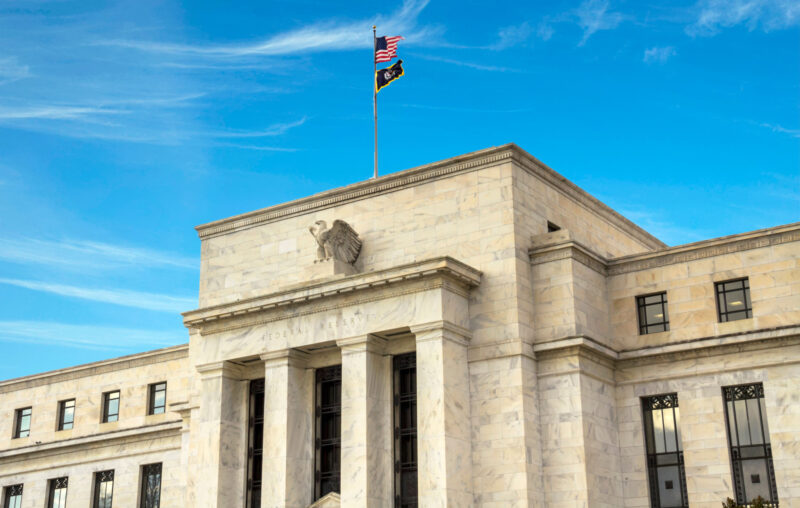


February’s inflation data were an unwelcome surprise. The Consumer Price Index (CPI) grew at a continuously compounding annualized rate of 4.4 percent on the month. Core CPI, which excludes volatile food and energy prices, grew 5.4 percent. The Fed still has some work to do on the inflation front.
Now it’s dealing with banking troubles, as well. The failures of Silicon Valley Bank and Signature Bank, as well as distress at several other institutions, complicates the Fed’s efforts to normalize monetary policy. Rising nominal interest rates depleted the value of these banks’ assets, especially Treasuries and mortgage-backed securities. The hit to bank capital made depositors skittish, causing a mass outflow of liquidity. Fed officials surely worry that additional rate hikes will make the banking problems worse. But additional rate hikes are required to bring down inflation.
The failed banks appear to have experienced classic bank runs. Contrary to popular perception, however, these were not random or “sunspot” events. The banks in question made bad investments, and built a precarious capital structure with depositor funds. It doesn’t take a financial genius to understand that the balance sheet must change when inflation puts upward pressure on nominal yields, and downward pressure on bond prices.
It’s also important to note the risk of a systemic crisis is low. The Office of Financial Research’s financial stress index is slightly elevated, but nowhere near March 2020 levels, let alone October 2008 levels. The St. Louis Fed’s measure currently shows lower-than-average financial turbulence. Given the small chance of a financial panic, the responsible thing to do would be to let the distressed banks fail, which would include costs for unduly trusting depositors. So, of course, policymakers at Treasury and the Fed have decided to do something else: even depositors holding more than the FDIC’s $250,000 guarantee will be made whole.
You can kiss any meaningful distinction between insured and uninsured depositors goodbye.
The Fed would have minimized the risk of moral hazard if it had acted as a classical lender of last resort. (And if my keyboard were a rocket ship, I could go to the moon.) The Fed has never behaved as a responsible last-resort lender. Instead, it lends indiscriminately, according to opaque criteria that it makes up as a crisis unfolds.
We can castigate excessively risky behavior by private banks all we want. But given a 40-year record of bailouts, why wouldn’t bank executives load up on risk? ‘Heads,’ the risks pan out and they make a killing; ‘tails,’ the risks blow up and taxpayers (or other depository institutions) pick up the losses.
The only silver lining is that bad bailout policy might leave the Fed free to pursue good inflation policy. You can calm a financial crisis before it begins, if you throw enough of other peoples’ money at distressed institutions, which is the Fed’s and Treasury’s preferred approach. I don’t recommend this strategy if you want a healthy capital-allocation sector. But it does mean the Fed can continue raising interest rates without obsessing over banks’ balance sheets.
If underlying inflation is 5.4 percent, as the most recent core CPI reading suggests, we’re very close to neutral territory already. The current Fed funds rate target range is 4.50 to 4.75 percent. On an inflation-adjusted basis, that’s -0.90 to -0.65 percent. Many economists think the “neutral” rate (the level compatible with low and steady inflation) is 0.25 to 0.5 percent. But rates might not have to rise by the full 1.15 percentage-point difference to get there. If the CPI overstates inflation, as many economists believe; and supply chains continue to ease up, which seems likely; one or two more 25 basis-point increases might be sufficient.
While financial stabilization policy and inflation policy are connected by interest-rate effects, they remain economically distinct. A good rule of thumb is “one instrument, one goal.” The Fed should continue its interest-rate policy with disinflation as the objective. That probably means we have more bad bailouts in our future. But based on the political incentives, we would have gotten those anyway. To the shame of two generations of economists-turned-policy-advisors, moral hazard is a fact of life. We don’t need to add permanent dollar depreciation to this mess.
TELL YOUR FRIENDS ABOUT CITIZENS JOURNAL Help keep us publishing –PLEASE DONATE




